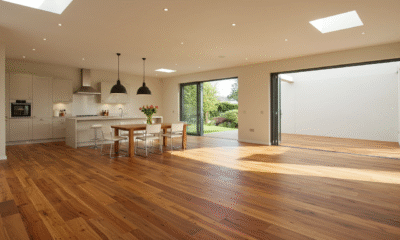

Environment
Creating a Green Basement Environment for a Healthier Home
Forty-eight percent of Americans want to do more to help the planet. One of the steps they need to take is to perform eco-friendly renovations in their homes.
Are you trying to create an eco-friendly home? You need to think about the environment when designing every room.
When the interior designing of your home comes together, there’s the feelings of joy, excitement, and accomplishment. But unlike the rest of the home, there’s a chance the basement is still a plain, concrete space that’s just waiting to be brought to life. But completing a finished basement project is no small undertaking.
Whether you’re looking to create an extra party room or a miniature theater, it is important that your basement presents a green and healthy environment for you and your loved ones. You will want to make sure that your basement renovation is performed in an eco-friendly manner. Without the right measures in place, your finished basement could become an unhealthy space and may require repairs down the road. Furthermore, with the way our world is changing, you may have thought about how you can do your part to limit your energy-consumption footprint on the environment.
Let’s take a look into how you can create an environmentally friendly basement that’s good for you and for the world!
What Materials Are You Using?
When aiming for a green basement environment, you’ll want to take care of what materials you choose in piecing together your basement. This goes for both what you and your guests can see, as well as what’s beneath the surface. There are a lot of eco-friendly building materials worth using.
Eco-friendly materials such as recycled wood, reclaimed wood, and recycled plastic are just some of the kinds of materials you may use in making your finished basement. You can also use what’s known as FSC, or Forest Service Council, certified wood. This wood is harvested in a sustainable way, so you won’t have to worry about contributing to deforestation problems. Reclaimed wood can also help slow the harvesting of living trees.
Traditional insulation is made of materials such as fiberglass and polystyrene. Unfortunately, these can release VOCs (Volatile Organic Compounds) into the air of your basement. VOCs have been known to cause cancer. They can also cause other side effects such as nausea and irritation to the eyes and throat. One green alternative for wall insulation is cellulose insulation, which is made of plant material and recycled materials such as newspaper.
You should also consider a flooring option that does not release VOCs into your basement air. Many types of flooring unfortunately have this problem. But natural fiber carpeting, reclaimed wood, ceramic tile, and even bamboo can provide a safe and green alternative to your basement’s flooring.
Does Your Basement Need Waterproofing?
Before you begin insulating and drywalling your basement walls, you should make sure that your basement has been properly waterproofed. This is to help protect your basement, and your home by extension, from the damaging effects of invasive water and moisture.
Drainage channels will need to be installed beneath your floor slab, placed along the perimeter of your interior basement wall. This will help redirect incoming groundwater towards a sump pit where a sump pump can push it out of your basement and home. Other components may be installed, such as moisture vapor barriers to protect against moisture coming through your basement walls.
Waterproofing will keep your basement dry. It will also help reduce the water pressure on the exterior walls of your basement. This will keep your basement wall and slab safe from damage caused by what’s known as “hydrostatic pressure”. Foundation cracks and bowing basement walls are just two of the possibilities that can happen from this immense water pressure.
Water and moisture in your basement can seriously harm your basement’s environment. A wet basement creates the perfect environment for problems such as these…
- Mold growth
- Wood rot in wooden structures
- Rust to any equipment in the basement, such as an HVAC or water heater
- Attraction of pests such as termites and rodents
Mold spores can trigger allergic reactions and even worsen asthma symptoms. Wood rot and termites can damage the wooden structures in your basement. Meanwhile, rodents can contaminate surfaces as they forage. Keeping your basement dry is key to maintaining a green and healthy basement.
Keeping Your Basement in the Green with Basement Waterproofing
Your basement is as important as any other part of your home. It will be an even better part once it’s been finished! Therefore, it should be treated by a basement waterproofing company that you can trust.
A wet basement can ruin all the hard work you put into making your basement a healthy and useable addition to your home life. Be sure to find a contractor that has decades of experience behind their services and methods. They should also offer a strong warranty and have a lot of positive reviews to confirm the quality of their basement waterproofing solutions. By making sure that they meet these criteria, your basement will be protected against outside water, and it will be ready to become the green basement of your dreams!


 Environment10 months ago
Environment10 months agoAre Polymer Banknotes: an Eco-Friendly Trend or a Groundswell?

 Environment12 months ago
Environment12 months agoEco-Friendly Home Improvements: Top 7 Upgrades for 2025

 Features9 months ago
Features9 months agoEco-Friendly Cryptocurrencies: Sustainable Investment Choices

 Features10 months ago
Features10 months agoEco-Friendly Crypto Traders Must Find the Right Exchange


























